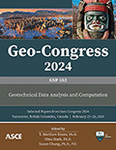Using Machine Learning to Predict Consolidation Parameters
Publication: Geo-Congress 2024
ABSTRACT
While one-dimensional consolidation tests remain the benchmark for performing site-specific evaluations of consolidation characteristics, the time required to perform these tests has resulted in significant research interest in correlating consolidation and recompression indices to more readily available properties such as natural moisture content or liquid limit. Recent advances in machine learning provide the ability to analyze and draw inferences from a combined range of soil properties to better estimate the consolidation and recompression indices. This study utilizes a dataset of consolidation tests (n = 1,261) performed primarily on Holocene age clay and organic materials within the New Orleans area to evaluate the applicability and use of various machine learning algorithms, including multivariate ordinary least squares and random forest regressors. The results of these models are compared to traditional univariate linear regressions and provide commentary on the use of machine learning to statistically treat the variability inherent in geotechnical testing.
Get full access to this article
View all available purchase options and get full access to this chapter.
REFERENCES
Ahadiyan, J., Ebne, J. R., and Bajestan, M. S. (2008). “Prediction determination of soil compression index Cc in Ahwaz region. J. Faculty Eng., 35(3), 75–80.
Al-Khafaji, A., and Andersland, B. O. (1992). “Equations for Compression Index Approximation.” Journal of Geotechnical Engineering, 118(1), 148–153.
Al-Khafaji, A., Maillacheruvu, K., and Jacobs, R. (2017). “Analysis of Empirical Compression Index Equations Using the Void Ratio.” Proceedings of the Ninth International Structural Engineering and Construction Conference, Valencia, Spain.
Azzouz, A. S., Krizek, R. J., and Corotis, R. B. (1976). “Regression Analysis of Soil Compressibility.” Soils and Foundations, Japanese Society of Soil Mechanics and Foundation Engineering, 16(2).
Bowles, J. E. (1989). Physical and Geotechnical Properties of Soils. McGraw-Hill Book Co., Inc., New York, NY.
Belsley, D. A., Kuh, E., and Welsch, R. E. Regression Diagnostics. Wiley, 1980: Section 3.2.
Brandon, T., Martin, L., Martin, S., and Xu, G. (2011). Strength and Compressibility Correlations for New Orleans Area Soils. Virginia Tech.
Breiman, L. (2001). “Random Forests.” Machine Learning, 26(2): 123–140.
Casagrande, A. (1936). “The determination of the pre-consolidation load and its practical significance”. Proceedings of the international conference on soil mechanics and foundation engineering. Vol. 3. Harvard University Cambridge, pp. 60–64.
Cozzolino, V. M. (1961). “Statistical forecasting of compression index.” Proceedings of the 5th International Conferenc eon Soil Mechanics and Foundation Engineering, Paris, France, Vol. 1, 51–53.
Deubert, T. (1982). Correlation of Compression Index and Soil Properties. Tulane University.
Harris, B., and Jafari, N. (2018). Barataria Basin Compressibility Correlations. Louisiana State University.
Herrero, O. R. (1983). “Universal compression index equation; Closure.” Journal of Geotechnical Engineering, ASCE, 109(5), 755–751.
Hough, B. K. (1957). Basic soils engineering. 1st Ed., The Ronald Press Company, New York, NY.
Koppula, S. D. (1981). “Statistical estimation of compression index.” Geotechnical Testing Journal, 4(2), 68–73.
Mayne, P. W. (1980). “Cam-clay predictions of undrained strength.” J. Geotech. Eng. Div., 106(11), 1219–1242.
McClelland, B. (1967). Progress of consolidation in delta front and pro delta clays on the Mississippi River. University of Illinois.
Nam, B. H., Shamet, R., Kim, J. K., Xanthopoulos, P., and Panagopoulos, O. (2019). Development of Statistical Models to Predict the Compressibility of Florida’s Soils. Florida Department of Transportation.
Nishida, Y. (1956). “A brief note on compression index of soil.” Journal of Soil Mechanics and Foundation Engineering, ASCE, 82(3): 1–14.
Park, H., and Lee, S. R. (2011). “Evaluation of the compression index of soils using an artifical neural network.” Computers and Geotechnics, 38(4), 472–481.
Sowers, G. B. (1970). Introductory Soil Mechanics and Foundations. 3rd Ed, The Macmillan Company, Collier Macmillan Limited, London, 102.
Terzaghi, K., and Peck, R. B. (1967). Soil mechanics in engineering practice, 2nd Ed., Wiley.
Yoon, G. L., Kim, B. T., and Jeon, S. S. (2006). “Regression Analysis of Compression Index for Kwangyang Marine Clay.” KSCE Journal of Civil Engineering, 10(6), 415–418.
Information & Authors
Information
Published In
History
Published online: Feb 22, 2024
ASCE Technical Topics:
- Artificial intelligence and machine learning
- Benchmark
- Business management
- Computer programming
- Computing in civil engineering
- Consolidated soils
- Engineering fundamentals
- Geomechanics
- Geotechnical engineering
- Hydrologic engineering
- Hydrologic properties
- Hydrology
- Management methods
- Mathematics
- Parameters (statistics)
- Practice and Profession
- Soil analysis
- Soil mechanics
- Soil properties
- Soil tests
- Soils (by type)
- Statistics
- Tests (by type)
- Water and water resources
- Water content
Authors
Metrics & Citations
Metrics
Citations
Download citation
If you have the appropriate software installed, you can download article citation data to the citation manager of your choice. Simply select your manager software from the list below and click Download.
